The Hobbit: The Battle of the Five Armies
6.6 /10 1 Votes6.6
61% Rotten Tomatoes Film series The Hobbit Duration Language English | 7.5/10 IMDb 59% Metacritic Genre Adventure, Fantasy Initial DVD release March 24, 2015 (USA) Country New ZealandUnited States | |||||||||||||||||||||||||||||||||
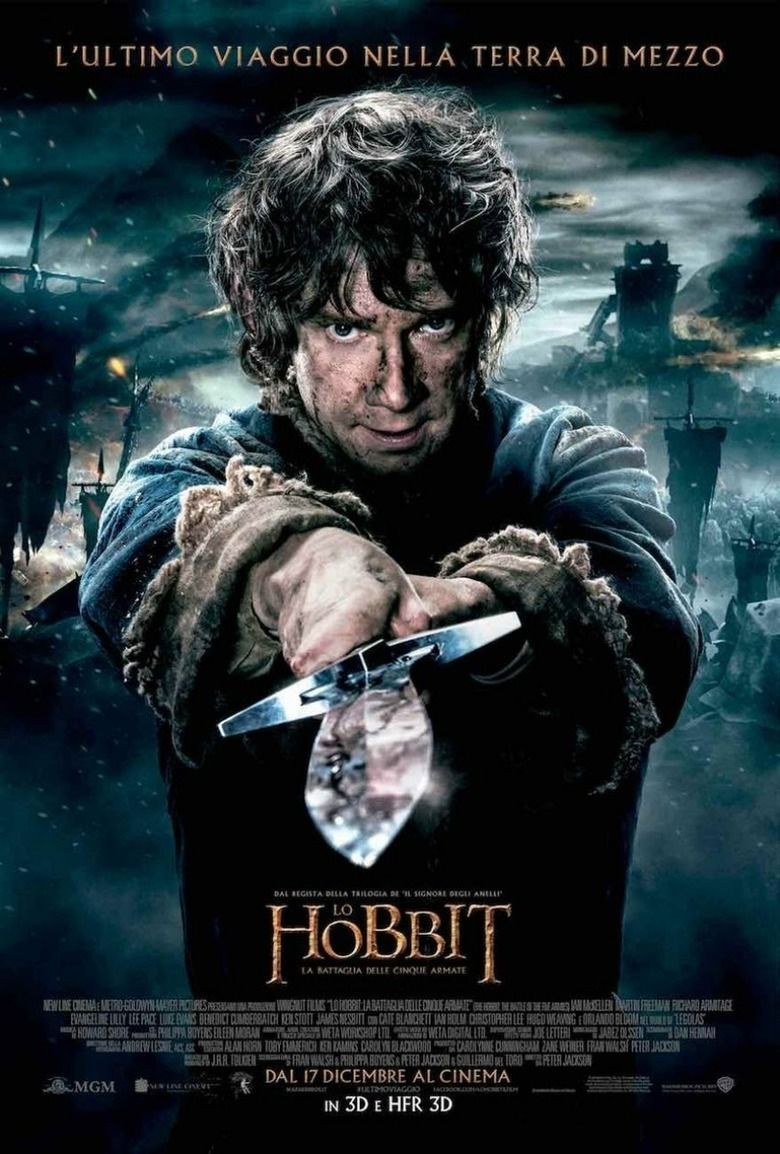 | ||||||||||||||||||||||||||||||||||
Release date 1 December 2014 (2014-12-01) (London premiere)11 December 2014 (2014-12-11) (New Zealand)17 December 2014 (2014-12-17) (United States) Writer Fran Walsh (screenplay), Philippa Boyens (screenplay), Peter Jackson (screenplay), Guillermo del Toro (screenplay), J.R.R. Tolkien (novel) Cast Similar movies , The Lord of the Rings: The Fellowship of the Ring , The Lord of the Rings: The Return of the King , , The Hobbit: An Unexpected Journey , Warcraft Tagline Witness the defining chapter of the Middle-Earth saga | ||||||||||||||||||||||||||||||||||
The hobbit the battle of the five armies official trailer 1 2014 peter jackson movie hd
The Hobbit: The Battle of the Five Armies is a 2014 epic high fantasy action film directed by Peter Jackson and written by Jackson, Fran Walsh, Philippa Boyens, and Guillermo del Toro. It is the third and final installment in Peter Jackson's three-part film adaptation based on the novel The Hobbit by J. R. R. Tolkien, following An Unexpected Journey (2012) and The Desolation of Smaug (2013), and together they act as a prequel to Jackson's The Lord of the Rings film trilogy. It was produced by New Line Cinema, Metro-Goldwyn-Mayer and WingNut Films, and distributed by Warner Bros. Pictures. The Battle of the Five Armies was released on 11 December 2014 in New Zealand, 12 December 2014 in the United Kingdom, and on 17 December 2014 in the United States. It stars Martin Freeman, Ian McKellen, Richard Armitage, Evangeline Lilly, Lee Pace, Luke Evans, Benedict Cumberbatch, Ken Stott, and James Nesbitt. It also features Cate Blanchett, Ian Holm, Christopher Lee, Hugo Weaving, and Orlando Bloom. The film received mixed reviews and grossed over $956 million worldwide, making it the second highest-grossing film of 2014 and the 38th highest-grossing film of all time. At the 87th Academy Awards, the film received a nomination for Best Sound Editing.
Contents
- The hobbit the battle of the five armies official trailer 1 2014 peter jackson movie hd
- The hobbit the battle of the five armies official final trailer 2014 peter jackson movie hd
- Plot
- Cast
- Development
- Score
- Marketing
- Video games
- Theatrical release
- Home media
- Box office
- North America
- Outside North America
- Critical response
- The hobbit the battle of the five armies featurette 17 year journey 2014 movie hd
- The hobbit the battle of the five armies official teaser trailer 1 2014 peter jackson movie hd
- References
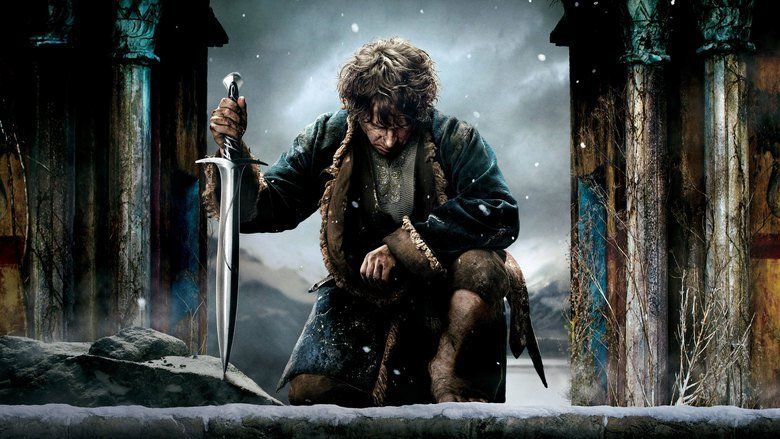
The hobbit the battle of the five armies official final trailer 2014 peter jackson movie hd
Plot

Bilbo and the Dwarves watch from the Lonely Mountain as the dragon Smaug sets Laketown ablaze. Bard the Bowman breaks out of prison, and eventually kills Smaug with the black arrow brought to him by his son Bain. Smaug's falling body crushes the fleeing Master of Laketown and his cronies, who were escaping from Laketown on a boat laden with the town's gold. Bard reluctantly becomes the new leader of the people of Laketown as they seek refuge in the ruins of Dale, while Legolas travels to investigate Mount Gundabad with Tauriel. Thorin, now struck with "dragon sickness" over the vast treasure in the mountain, searches obsessively for the Arkenstone, which Bilbo had previously found but kept hidden. Thorin, hearing that Laketown survivors have fled to Dale, orders the entrance of the Lonely Mountain sealed off.
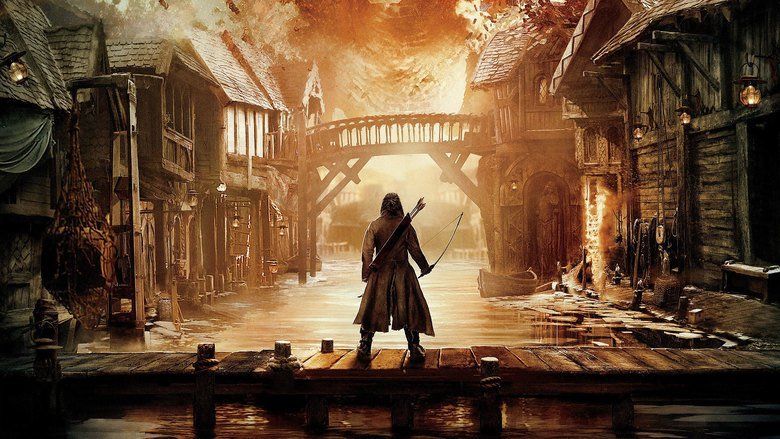
Meanwhile, Galadriel, Elrond, and Saruman arrive at Dol Guldur and free Gandalf, sending him to safety with Radagast. They battle and defeat the Nazgûl and a formless Sauron himself, banishing them to the East. Azog, marching on Erebor with his vast Orc army, sends his son Bolg to Gundabad to summon their second army. Legolas and Tauriel witness the march of Bolg's army, bolstered by Orc Berserkers and giant bats.

Thranduil and an elf army arrive in Dale and form an alliance with Bard in order to reclaim white gems that are part of the mountain treasure. Bard goes to the mountain and asks Thorin for the share of gold that he had previously promised the people of Laketown, but Thorin refuses. Gandalf arrives at Dale to warn Bard and Thranduil of the threat posed by Azog, but Thranduil dismisses him. Bilbo sneaks out of Erebor to hand the Arkenstone over to Thranduil and Bard so that they can trade it for the gems and gold they were promised and prevent a battle. When Bard and Thranduil's armies gather at the gates of Erebor, offering to trade the Arkenstone for the Elven white gems and the portion of gold promised Laketown survivors, Thorin angrily refuses to believe they have the Arkenstone until Bilbo admits giving it away and chides Thorin for letting greed cloud his judgement. Outraged by what he sees as betrayal, Thorin nearly kills Bilbo, but Gandalf arrives at the gate and shames Thorin into releasing Bilbo. Thorin's cousin Dáin arrives with his Dwarf army, and a battle of Dwarves against Elves and Men begins, with the Elves and Men having a significant advantage. Wereworms emerge from the ground, releasing Azog's army from their tunnels. With the Orcs outnumbering Dáin's army, Thranduil and Bard's forces, along with Gandalf and Bilbo, join the battle. However, a second front is opened when many Orcs, Ogres, and Trolls attack Dale.

Inside Erebor, Thorin suffers traumatic hallucinations before regaining his sanity and leading his company to join the battle. He rides towards Ravenhill with Dwalin, Fíli, and Kíli to kill Azog; Bilbo follows them using the One Ring to move through the combat unseen. Meanwhile, Tauriel leaves with Legolas following her to warn the Dwarves of Bolg's approaching army. Fíli and Kíli are cornered. Azog kills Fíli, as Bilbo and the other Dwarves look on. As Thorin engages Azog in a fight to the death, Bolg knocks Bilbo unconscious, overpowers Tauriel and then kills Kíli, who had come to her aid. Legolas battles Bolg and eventually kills him. Thorin kills Azog, but is fatally wounded in the process. The Great Eagles then arrive with Radagast and Beorn to fight the newly arriving Orc army, and the Orcs are finally defeated. Bilbo regains consciousness and makes peace with Thorin before he dies. Tauriel mourns Kili and Thranduil acknowledges their love. Legolas then tells Thranduil he must leave, and Thranduil advises him to seek out a Dunedain ranger in the north who goes by the name "Strider". Thorin, Fíli, and Kíli are respectfully laid to rest and Dáin is crowned King under the Mountain.
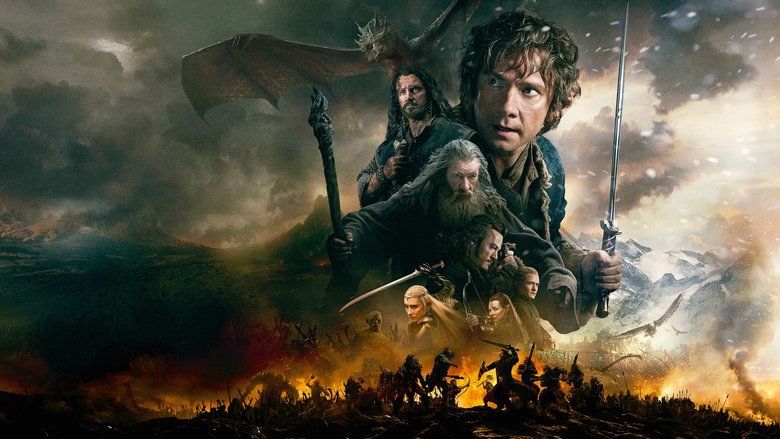
Bilbo bids farewell to the remaining members of Thorin's company and journeys home to the Shire with Gandalf. As the two part ways on the outskirts of the Shire, Gandalf admits his knowledge of Bilbo's ring and warns him that magic rings are not to be used lightly. Bilbo returns to Bag End to find his belongings being auctioned off by his least favourite relatives, the Sackville-Bagginses, because he was presumed dead. He cancels the sale, but finds his home pillaged. He starts to tidy up and takes the Ring out of his pocket. Sixty years later, Bilbo receives a visit from Gandalf on his 111th birthday.
Cast
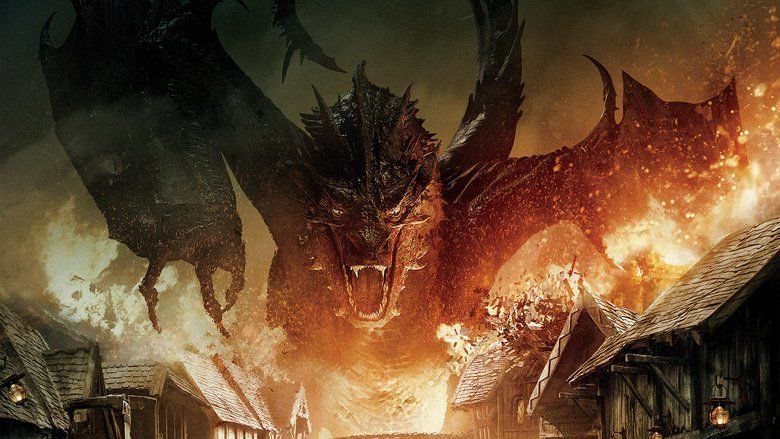
Additionally, Peter Jackson and Andy Serkis' daughters made cameo appearances as girls rowing away during Smaug's attack; movement coach Terry Notary and stand-in Jamie Haugh appear as Laketown refugees after the destruction; Conan Stevens, who was to play Bolg, appears as the Keeper of the Dungeons, an Orc captain holding Gandalf hostage and the sons of key second assistant director Guy Campbell, casting director Miranda Rivers, and Weta Workshop founder Richard Taylor appear as Hobbit children during the auction scene.
Development
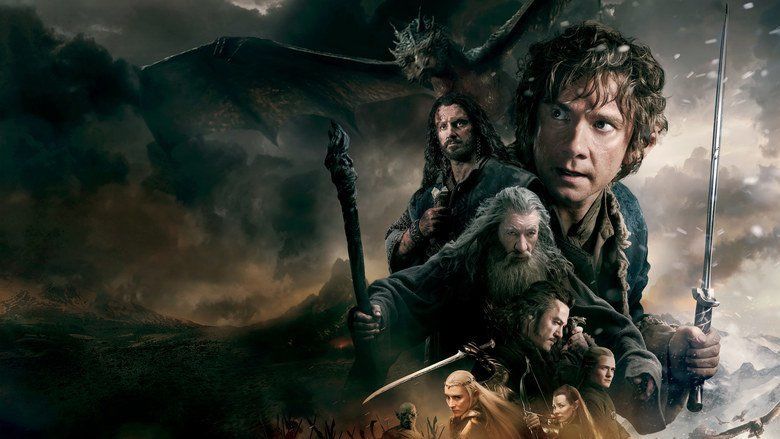
The Hobbit was originally envisioned as a two-part film, but Jackson confirmed plans for a third film on 30 July 2012, turning his adaptation of The Hobbit into a trilogy. According to Jackson, the third film would contain the Battle of the Five Armies and make extensive use of the appendices that Tolkien wrote to expand the story of Middle-earth (published in the back of The Return of the King). Jackson also stated that while the third film will largely make use of footage originally shot for the first and second films, it would require additional filming as well. The third film was titled There and Back Again in August 2012. In April 2014, Jackson changed the title of the film to The Battle of the Five Armies as he thought the new title better suited the situation of the film. He stated on his Facebook page, "There and Back Again felt like the right name for the second of a two film telling of the quest to reclaim Erebor, when Bilbo's arrival there, and departure, were both contained within the second film. But with three movies, it suddenly felt misplaced—after all, Bilbo has already arrived 'there' in the Desolation of Smaug." Shaun Gunner, the chairman of The Tolkien Society, supported the decision: "The Battle of the Five Armies much better captures the focus of the film but also more accurately channels the essence of the story."
Score
As with all the previous films, Howard Shore composed the score. Billy Boyd, who played Peregrin Took in The Lord of the Rings, wrote and recorded the song "The Last Goodbye" to be played over the end credits of the film.
Marketing
A teaser trailer for the film was released on 28 July 2014 attached to Guardians of the Galaxy, Into the Storm, and If I Stay. The second theatrical trailer was released on 6 November 2014 attached to Interstellar and The Hunger Games: Mockingjay – Part 1. To promote the film's release, Wellington-based association football club, Wellington Phoenix, wore a special designed jersey to commemorate the opening of The Hobbit: The Battle of Five Armies. The custom, film-themed jersey was worn only once, on 13 December 2014. In the film's Japanese release on 13 December, Warner Bros. collaborated with mobile gaming company A-Lim to bring Bilbo, Gandalf, and Legolas into the game Brave Frontier at the end of December as Vortex Dungeon units. The campaign only ran until February 2015. Smaug made a guest appearance, animated by WETA and voiced again by Cumberbatch, on the satire show The Colbert Report on 12 December 2014 to promote the film.
Video games
Two video games were developed to coincide with the film's theatrical release. A tie-in fighting video game The Hobbit: Battle of the Five Armies – Fight for Middle Earth was released simultaneously with the film for Android and iOS platforms to negative reviews from critics and users. An action-adventure video game Middle-earth: Shadow of Mordor was released for Microsoft Windows, PlayStation 4 & Xbox One in October 2014 and for PlayStation 3 and Xbox 360 on 21 November, nearly a week prior to The Hobbit: The Battle of the Five Armies world premiere in London, on 1 December. The events of the game take place directly after Sauron fled to Mordor, escaping The White Council, which was shown at the beginning of the film. The game was planned to act as an overlap between The Hobbit (film series) and The Lord of the Rings (film series).
Theatrical release
Initially the film was set for a July 2014 release however it was later pushed back to December. The world premiere of The Hobbit: The Battle of the Five Armies was held in London at Leicester Square on 1 December 2014. The film opened in theatres on 11 December 2014 in New Zealand, on 12 December in the United Kingdom and on 17 December in the United States. Warner Bros released the film on 18 December 2014 in Greece and 26 December in Australia. The film was released in China on 23 January 2015. An extended edition of the film had a one-night-only re-release on 13 October 2015, accompanied by a special greeting from Peter Jackson.
Home media
The Hobbit: The Battle of the Five Armies was released on 6 March 2015 on Digital Release from digital retailers. The DVD and Blu-ray were released on 24 March 2015 in the United States. It topped the home video sales chart in its opening week. An Extended Edition of the film, with 20 minutes of additional footage and original music was released on Digital HD on 20 October and on DVD, Blu-ray and Blu-ray 3D on 17 November 2015 in the United States and on 23 November 2015, in the United Kingdom. Unlike the theatrical version's PG-13 rating, the Extended Edition has been rated R by the MPAA for "some violence".
Box office
Like its predecessors, The Hobbit: The Battle of the Five Armies became a financial success. It grossed a total of $255.1 million in North America and $700.9 million in other countries for a worldwide total of $956 million. Worldwide, it is the second highest-grossing film of 2014 (behind Transformers: Age of Extinction), the lowest-grossing film of The Hobbit series, and the 33rd highest-grossing film of all time. According to Deadline.com's estimation, the film made a profit of $103.38 million. The film failed to earn $1 billion at the box office, despite various pundits projecting it to reach that milestone. The Hollywood Reporter said that The Battle of the Five Armies was unlikely to gross $1 billion worldwide due to "plunging exchange rates around the globe" witnessed that year, and that Warner Bros. and MGM ultimately would take in nearly $90 million less than expected due to the rising dollar and plunging foreign currencies. However, despite this failure, Forbes has declared the trilogy "an unmitigated financial grand-slam for all parties."
North America
In the U.S. and Canada, it is the lowest-grossing of the three films of The Hobbit trilogy, and also the lowest-grossing of the six Middle-earth adaptations, but the sixth highest-grossing film of 2014. It opened on Tuesday, December 16, 2014 at 7 p.m across 3,100 theaters and widened to 3,875 the following day. It earned $11.2 million from Tuesday late-night shows, which is the second highest of 2014, matching the numbers earned by Guardians of the Galaxy and both behind The Hunger Games: Mockingjay – Part 1 ($17 million) of which $2.5 million of just over 22% came from IMAX showings. This broke the record for a Middle-earth adaptation previews previously set by The Desolation of Smaug with $8.8 million. It then topped the box office on its opening day (Wednesday, December 17, 2014), earning $24.5 million (including previews), which is the third highest Middle-earth adaptation Wednesday opening behind the Wednesday openings of The Lord of the Rings: The Return of the King ($34.5 million) and The Lord of the Rings: The Two Towers ($26.2 million). In total, the film earned $57.4 million in its traditional three-day opening and $89.1 million over its five-day course making it the second biggest five-day opening in The Hobbit franchise, beating the $86.1 million opening of The Desolation of Smaug, but still behind An Unexpected Journey's $100.2 million five-day opening. However, on a three-day basis, the film underperformed expectations and fell short of its predecessors. The film set a December IMAX opening record with $13.4 million (previously held by Mission: Impossible – Ghost Protocol). 3D accounted for 49% of the total gross while IMAX generated 15% or $13.4 million over five days, and $7.4 million over three days, and premium large format screens comprised 8% of the total opening weekend gross with $7.2 million from 396 theaters. The film passed the $100 million mark on its seventh day (December 23, 2014). It became the third film of 2014 to earn $100 million in just under a week following Lionsgate's The Hunger Games: Mockingjay – Part 1 ($168.7 million in its opening week) and Disney/Marvel's Guardians of the Galaxy ($134.4 million in its first week). It was in first place at the North American box office for three consecutive weekends despite facing competition from numerous new releases each weekend, but was finally overtaken by Taken 3 in its fourth weekend.
Outside North America
The film began its international roll-out a week prior to its wide North American release. It opened Wednesday, December 10, 2014 in 11 European markets, earning $11.3 million and December 11, 2014 in 17 additional markets, earning $13.7 million, for a two-day total of $26.6 million and topped the charts in each of the territories. Through Sunday, December 14, 2015, it had an openening weekend total of $122.2 million from 37 countries in 15,395 screens, topping the box office and outperforming the previous two installments on a local currency and admissions basis. 71% of the total gross ($86.7 million) came from 3D showings. However, the overseas opening weekend was still lower than the openings of An Unexpected Journey ($138 million) and The Desolation of Smaug ($135.4 million) – both on a dollar basis. It set a December IMAX opening record with $6.4 million across 160 IMAX screens, previously held by An Unexpected Journey with $5.03 million. The film opened to an additional 59 countries in its second weekend and earned $109 million from 19,315 screens still holding the top spot and fell gradually by 13% as a result of facing minor competitions. In its third weekend, the film added a further $89 million abroad, remaining at No. 1. It was in first place at the box office outside North America for four consecutive weekends and five in total.
The film achieved numerous records in international markets during its opening weekend. It set an all-time Warner Bros. opening record in Russia ($13.75 million), Argentina ($2.1 million), Sweden, and Finland. It also set a 2014 opening record in Germany ($20.5 million), France ($15.05 million), and Spain ($6.3 million). It also had the best Middle-earth saga opening in the UK ($15.2 million) and Mexico ($6.3 million). In Brazil, the film scored the second biggest Warner Bros. opening of all time with $6.8 million (behind Harry Potter and the Deathly Hallows – Part 2). In Australia, the film was released on 26 December 2014 and set an opening day record with $5.59 million, which is the biggest of 2014, the second biggest Boxing Day gross, and the fourth biggest ever in Australia behind Harry Potter and the Deathly Hallows – Part 2 ($7.092 million), The Avengers ($6.004 million), and The Hobbit: The Desolation of Smaug ($5.9 million). It went on to earn $10.1 million in its opening weekend. The film set an all-time opening record for Warner Bros. in China where it earned $49.84 million in its opening weekend (a record previously held by Pacific Rim). IMAX generated $6.8 million of the total gross, which was once the second highest IMAX three day gross behind Transformers: Age of Extinction's $10 million. Other high openings were recorded in Korea ($10.4 million), Poland ($5.6 million), Italy ($5.6 million), Malaysia ($3 million), and Taiwan ($2.75 million). In total earnings, its largest markets are China ($121.7 million); UK, Ireland, and Malta ($61.3 million); and Australia ($27 million).
Critical response
MTV reported that early reviews for The Hobbit: The Battle of the Five Armies were "generally positive" with critics praising the film "for its energy, shorter running time and satisfying closure". According to IBT, reviews for the film were mostly positive, with critics "praising director Peter Jackson's effort at transforming J.R.R Tolkien's fantasy novel into an epic adventure film trilogy". According to CBS News, critics said the film "will satisfy fans" but "otherwise, it may be worth waiting until it's available to rent". Oliver Gettel of the Los Angeles Times said the critical consensus was that the film is "a flawed but fitting finale to The Hobbit trilogy". The review aggregator website Rotten Tomatoes reported a 59% approval rating based on 232 reviews, with an average rating of 6.2/10. The website's consensus reads "Though somewhat overwhelmed by its own spectacle, The Hobbit: The Battle of the Five Armies ends Peter Jackson's second Middle-earth trilogy on a reasonably satisfying note." The film also holds a Metacritic score of 59 out of 100 based on 45 critics, indicating "mixed or average reviews". In CinemaScore polls conducted during the opening weekend, cinema audiences gave the film an average grade of "A-" on an A+ to F scale.
Scott Foundas of Variety said "The result is at once the trilogy's most engrossing episode, its most expeditious (at a comparatively lean 144 minutes) and also its darkest – both visually and in terms of the forces that stir in the hearts of men, dwarves and orcs alike." Todd McCarthy of The Hollywood Reporter said "After six films, 13 years and 1031 minutes of accumulated running time, Peter Jackson has concluded his massively remunerative genuflection at the altar of J.R.R. Tolkien with a film that may be the most purely entertaining of any in the collection." Andrew Pulver of The Guardian said "This film is a fitting cap to an extended series that, if nothing else, has transformed Tolkien's place in the wider culture." Chris Tilly from IGN Movies said "There's a little too much padding in the final Hobbit flick, and the best sequence is without doubt the film's first. But the central battle is indeed spectacular, and as 'The Age of Orc' approaches, it rounds out this particular story in stirring and emotional fashion." Russell Baillie of The New Zealand Herald said The Hobbit: The Battle of the Five Armies is "something less than the supposed 'defining chapter' of Jackson's time in Middle-earth as it's been billed. But action-wise, it certainly goes out with a very pleasing bang."
Conversely, Inkoo Kang of TheWrap said "The 144-minute running time showcases Jackson's worst tendencies: eons-long battle scenes, sloppy and abrupt resolutions, portentous romances, off-rhythm comic timing, and, newly in this case, patience-testing fan service." Tim Robey of The Daily Telegraph described the film as "a paragraph on steroids" that was "neither very terrible nor remotely unexpected. It's a series of stomping footnotes in search of a climax." The BBC's Nicholas Barber wrote that with The Hobbit series, Jackson had succeeded in bridging the gap between The Hobbit and The Lord of the Rings and that The Battle of the Five Armies was a "colossal technical achievement", but he also criticised that the film as such was not compelling because of "its repetitive battle scenes and a lack of plot". Nicolas Rapold of The New York Times said "Bilbo may fully learn a sense of friendship and duty, and have quite a story to tell, but somewhere along the way, Mr. Jackson loses much of the magic."
The hobbit the battle of the five armies featurette 17 year journey 2014 movie hd
The hobbit the battle of the five armies official teaser trailer 1 2014 peter jackson movie hd
References
The Hobbit: The Battle of the Five Armies WikipediaThe Hobbit: The Battle of the Five Armies IMDbThe Hobbit: The Battle of the Five Armies Rotten TomatoesThe Hobbit: The Battle of the Five Armies MetacriticThe Hobbit: The Battle of the Five Armies themoviedb.org
